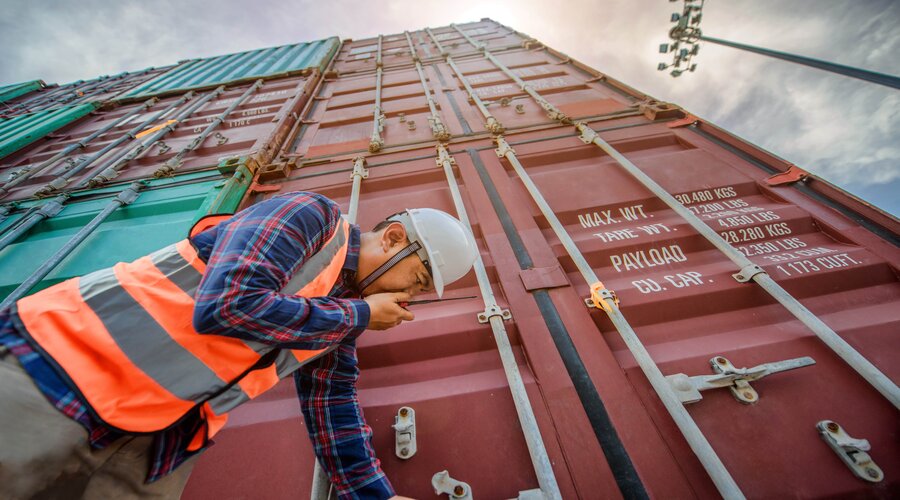How to Maintain a Shipping Container for Longer Lifespan

Shipping containers travel thousands of kilometres between the point of origin and the final destination, during which time they are subjected to various environmental variations. To ensure uninterrupted flow, maintaining freight containers is a very important step.
However, to some extent, shipping container damage is inevitable and can happen anywhere during the trip. Small damage that is often overlooked leads to major damage to the shipping box and a reduction in the life of the box. Regular container maintenance helps control damage and minimises time, money and misery. Understanding the many types of cargo damage and how to increase the lifespan of shipping containers is essential.
Top reasons for container damages

It is difficult to pinpoint the exact cause of the shipping or freight container damage. Working with shipping and handling containers is a complex process with many steps. From loading and transporting to unloading, containers pass through many hands and end up being mishandled along the way. However, there are some common reasons why containers are damaged.
Bad weather
The next factor affecting container damage is the weather. The weather is unpredictable and causes damage inside and out. The air near the ocean is highly humid, and when trapped in a container, they settle in cooler areas.
Wrong handling when loading and unloading
The container was also damaged during loading and unloading. Inexperienced forklifts can cause punctures and dents, uneven stacking or spilling of containers.
Choosing the wrong means of transportation
Another reason they can be damaged is due to an inappropriate multimodal transport method. Failure to properly secure the boxes can lead to punctures and dents around the body of the box. In addition, improper stowing during transportation or the wrong shipping method can lead to an accident. Train derailment, thermal damage due to inadequate protection, and road accidents can occur during the transition.
Poor storage
One of the most common causes of physical damage to a cargo unit is improper fixing. Overpacking, uneven weight distribution, loose cargo handling, and improper use of dunnage can all cause cargo to sway during transit.
Ways to maintain shipping containers longevity

Insulate the doors and windows
Shipping containers usually have only a few moving parts in the door assemblies. However, as with any moving parts, they are subject to damage or wear and tear with repeated use and need maintenance to ensure they are in good working order. There are two essential things to do when repairing your shipping container door and ensuring proper sealing.
The first is cleaning them, and the second is lubricating them
Remove all dirt, grit and rust from door hinges and latch bars with a commercial cleaner. Lubricate the door hinges and latch bars to ensure they are in good working order. Applying a lubricating spray (like WD-40) to the hinge oil is easy, while good quality grease will work well for the cam. The shipping containers are also designed to be a completely enclosed environment and use rubber seals on doors and windows. These types typically have a lifespan of about ten years before they can fail and lose their ability to seal doors effectively. Keep them clean and replace them if they are cracked or worn.
Pay attention to the seals and modifications made
As said before, the fewer cuts and openings your container has, the better. So it would be best if you made sure that the upgrades you've made to your container house are adequately sealed.
It is essential that you pay special attention to the windows and doors of your container house. Indeed, these gaps can affect the interior and exterior of the container house. These are the main entry points for moisture. Improve your container home by using silicone or insulation to improve ventilation.
Try to protect the outside of the container as best as possible from UV exposure and moisture. For storage purposes, most containers will be pre-coated or may be coated with a special coating for corrosion resistance and protection from direct sunlight. In other cases, you can spray foam or stick foam sheets outside the container to keep out harmful sunlight, extreme heat, and moisture from metal surfaces. For homes and offices, consider both insulations as well as roofing and coating materials that are suitable for keeping walls moist and for housing walls and ceilings.

Inspect and treat the container floor
You can repair your shipping container's laminate flooring if it's rotten or cracked. One can replace the floor or its individual boards if it is damaged. However, if the steel bottom is corroded, you will have to replace the entire box.
Most shipping containers are equipped with 1/8 inch / 28 mm thick plywood flooring. They are usually made from birch and teak plywood. These floors are durable and water-resistant and can hold tons of weight indoors. But these floors are prone to damage often due to forklift overload, resulting in plywood cracking, delaminating, or holes. If you need to repair the floor of a shipping container, you can replace the entire floor or fix the damaged part by placing a thin sheet of metal over the hole or by screwing a piece of plywood into the board. Polyurethane or epoxy coatings can help extend the life of your container floor. Also, if you can't tell if the containers are new or old, be sure to paint them with anti-rust paint.
Opt for routine maintenance
If your shipping container is refrigerated or reefer, it might require routine maintenance. Preventive maintenance will prevent downtime and costly repairs from happening when you least expect it. Usually, this type of maintenance must be performed by qualified technicians. You can perform mechanical and electrical repairs to your refrigerated container with professional assistance and ensure the interior is clean and food safe if needed. Take some time on a regular basis to make sure your plumbing is kept from leaking.
This includes inspecting all faucets, valves, pipes, and any other plumbing you have installed. Checking your plumbing as a part of your shipping container maintenance routine will significantly reduce your chances of experiencing unprecedented water damage.

Hire shipping containers and side loaders from a reliable transport service
Sideloader, also known as sidelifter or self-loading trailer, provides a flexible and economical way to load, transport and unload containers and other goods. It allows you to win new business, customers and revenue in a market where container handling is constantly increasing.
Most of the specialised container transport Melbourne offers rentals, an excellent option for those who want a temporary storage or transportation solution. Mounted on trucks or trailers, sideloaders can be operated with minimal workforce and without additional equipment, minimising wait times, planning and helping to provide safe, secure and consistent shipping service.

